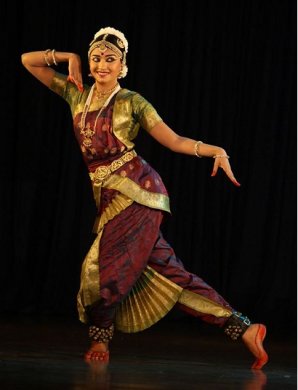
|   |

|   |
Sumitra Keshava: Sincere and sinuous - Naveena e-mail: naveena_b_2002@yahoo.co.in Photo: Chella Studio March 15, 2016 Watches, knives, chocolates, cheese and snow clad mountains - if these are the images that Switzerland conjures in one’s mind, Swiss-born Sumitra Keshava’s dance possesses the same attributes that one associates with those images. With a fine, precise yet graceful technique, a sweet countenance and a smooth yet firm grip on the grammar of this lofty art, Sumitra is a worthy legatee of the Mysore school of Bharatanatyam. Sumitra’s father and guru, D. Keshava, is a disciple of Venkatalakshamma, a Rajadasi of the Wodeyars and one of the principal proponents of the Mysore bani.  Sumitra Keshava danced on February 19 in Chennai as part of the Sarasa Natya Mala festival organised by dancer Shanmugasundaram, to perpetuate the memory of Bharatanatyam doyenne K.J. Sarasa. As such, the Mysore school is akin to the Vazhuvoor school of which Sarasa was one of the torch-bearers. Yet, aficionados would notice little differences, such as in hasta-viniyogas, and the abhinaya that is slightly more spontaneous. Devoid of modern day fireworks, this style steeped in classicism is nevertheless attractive. It is in the varnam that one could see the prowess of the young dancer in full blossom. “Ey maguva bodhincheraa?” asks the heroine. Sumitra’s portrayal of the heroine who pleads with the hero, as well as her delineation of the ‘other woman’ (who has supposedly poisoned his mind), replete with a humorous tinge in showing the latter’s loquaciousness and reed-like personality, were some of the high points. Sumitra’s confidence and competence at footwork were indicated in the way she went about the rhythmic passages assuredly, without batting an eyelid despite ace mridangist Keshavan’s cross-rhythms. Earlier, the recital opened with the Gayatri mantra. This writer is somehow not much in favour of mantras being used for art, since a mantra essentially protects one who ruminates upon it (mananaat traayate iti mantram) within himself. Chanting it softly and saying it out loud, count lower and lowest respectively, in hierarchy of usage. Technicalities apart, the curtains opened to reveal a petite, confident and very hardworking dancer of the Indian diaspora settled in Swiss soil, clad in aesthetic purple/maroon-green. The pushpanjali in praise of Bhudevi, penned in Sanskrit by Keshava himself, was another novel offering. It is not uncommon for dancers to be taught the verse “Samudra-vasane devi..Paada-ghaatam kshamasva mey,” a verse which beautifully asks Mother Earth to pardon the sin of hitting with the (dancer’s) feet. A pushpanjali dedicated to the Earth came across as a whiff of fresh air. While the dance itself was fault free, the Sanskrit passionista that yours truly is, could not help but notice the incorrect usage of addressing (sambodhanam) of the divine Mother Earth as ‘Jaganmaatey’ while it should be ‘Jaganmaatah.’ Another verse which was performed prior to the varnam, was the famed “Devaanaam idam” from Kalidasa’s Malavikaagnimitram, describing how Natya, having been bifurcated into tandava and lasya by Shiva and Parvathi respectively, is a source of sheer enjoyment for all people, despite having varied preferences. Perhaps this would have been more suitable for an invocatory verse than the Gayatri mantra. The other pieces that were performed post-varnam were the Devaranama, “Yaake nirdaya” and a thillana in ragam Kaapi. This final item, a composition of Chamarajendra Wodeyar, choreographed by Dr. K. Venkatalakshamma, was yet another mirror to the graceful Mysore bani and was executed well by the young artiste. The melodious orchestra comprised of D. Keshava (nattuvangam), Murali Parthasarathy (vocal), N.K. Keshavan (mridangam) and Sujit Naik (flute). It is heartening to see Indian art alive in Europe, which has a negligible Indian population. Talented, committed artistes like Sumitra Keshava who merge into the culture of the nation they are born and bred in, while continuing to also stay in touch with their roots, are to be truly encouraged. This young dancer, a jurist by qualification, also teaches dance in Switzerland. With experience and refinement that is bound to accrue by passage of time and greater exposure, she is sure to prove herself a noteworthy artiste. Naveena is passionate about language and arts and is a writer, translator, speaker, singer, quizzer and compere. Proficient in several languages including Sanskrit, she is sought after by artistes for better understanding and interpretation of lyrics for their academic and artistic pursuits. |